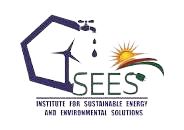ISEES promotes the use of solar energy equipment for lighting, heating, water pumping and community lighting. We provide solutions through the dissemination of appropriate solar technologies for solving off-grid community challenges. We also provide sustainable financing schemes for helping pro-poor communities and households increase access to and use of solar technologies. We partner with the private sector and micro-finance institutions to be able to make solar systems, technologies and equipment available, affordable and accessible to end-users who need it most.
These systems include:
- Solar Home System for basic house lighting, radio and TV operation;
- Solar Hospital System for vaccine refrigeration and lighting;
- Solar School System for classroom lighting and television for distance education;
- Solar Streetlight System for lighting general meeting points, such as markets, lorry stations, water supply points and important busy paths/roads requiring visibility;
- Solar Water Pumping System for the provision of water and
We provide further training in solar installation among others to youth and persons interested in going into solar businesses.
The Context in Ghana
Solar radiation and sunshine duration data have been collected by the Ghana Meteorological Services Agency for over 50 years. The daily irradiation data has a probable error of 15%. Currently the Mechanical Engineering Department at Kwame Nkrumah University of Science and Technology, Kumasi is measuring hourly global and diffuse irradiance using standard instruments that have a probable error of 5%. The average duration of sunshine varies from a minimum of 5.3 hours per day at Kumasi, which is in the cloudy semi-deciduous forest region, to 7.7 hours per day at Wa, which is in the dry savannah region. The monthly average solar irradiation in different parts of the country ranges between 4.4 and 5.6kWh/m2 /day (16-20 MJ/m /day)
The northern regions and the northern parts of Brong-Ahafo and Volta Regions receive very high radiation levels with monthly average of between 4.0 and 6.5kWh/m2 /day. The area experiences one major rainy season between July and September. The Harmattan is prevalent between November and February. Ashanti, parts of Brong-Ahafo, Eastern, Western and parts of Central and Volta regions have monthly average radiation level of 3.1 – 5.8 kWh/m2 /day. The water vapour in the atmosphere causes greater absorption and scattering producing high levels of diffuse radiation. Greater Accra, and the coastal regions of Central and Volta Regions have monthly average radiation levels ranging from 4.0 – 6.0 kWh/m2 /day. Over 4,500 solar systems have been installed in over 89 communities throughout the country.
